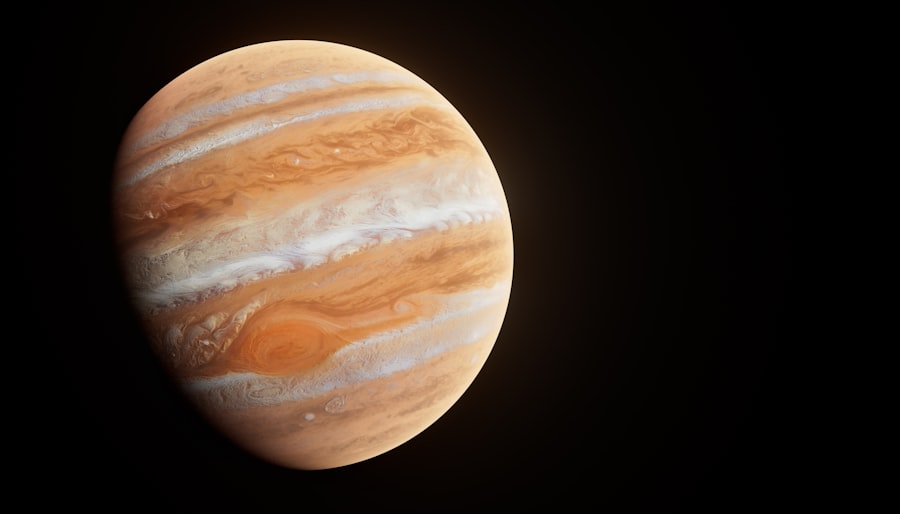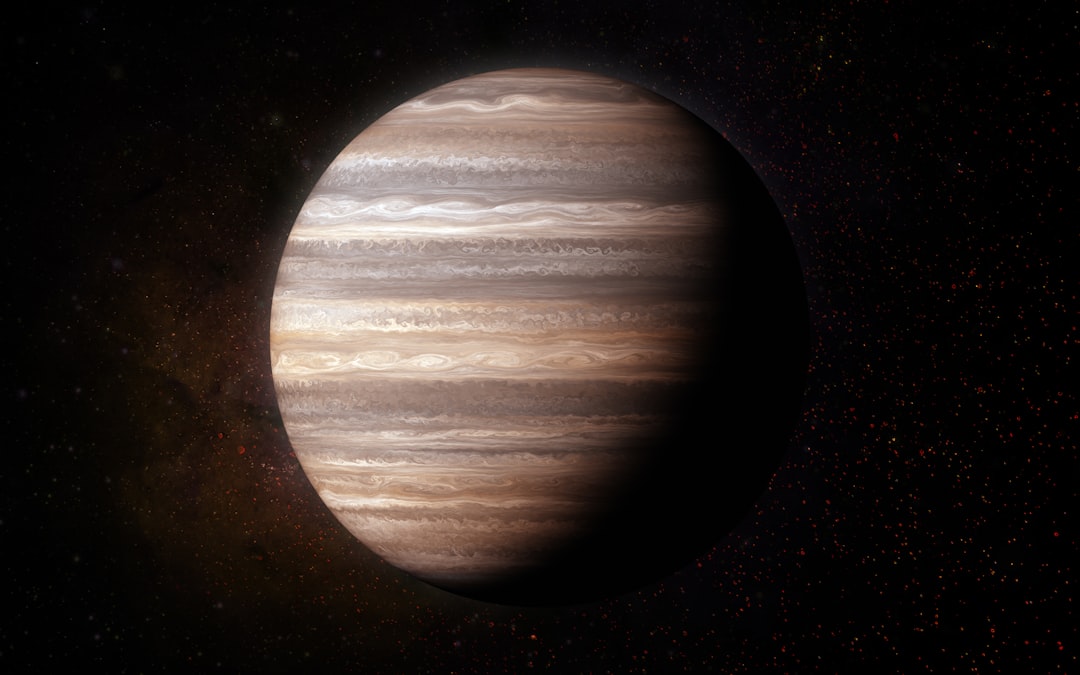Jupiter, the largest planet in our solar system, has long captivated the imagination of astronomers and laypeople alike. Its immense size and striking features make it a focal point of study and speculation.
This characterization stems from its intricate atmospheric phenomena, powerful magnetic field, and numerous moons, all of which contribute to its enigmatic nature. As scientists continue to explore this giant planet, they uncover layers of mystery that challenge our understanding of planetary formation and dynamics. The allure of Jupiter extends beyond its physical attributes.
It serves as a window into the processes that govern not only its own existence but also the evolution of the solar system as a whole. The planet’s unique characteristics prompt questions about its origins, its role in shaping the orbits of other celestial bodies, and even the potential for life in its diverse system of moons. As researchers delve deeper into the mysteries of Jupiter, they are not only expanding our knowledge of this alien machine but also redefining our place in the cosmos.
Key Takeaways
- Jupiter is a mysterious giant in our solar system, with unique features and a powerful magnetic field.
- Its composition and structure are still not fully understood, but it plays a crucial role in the dynamics of the solar system.
- Jupiter’s moons are mini-worlds with potential for life, making them a target for future exploration and colonization.
- The alien machine hypothesis and theories about Jupiter’s origins add to the enigmatic nature of this planet.
- Jupiter’s influence on human imagination, as seen in mythology and culture, reflects its enigmatic and captivating presence in our solar system.
The Mysterious Giant: Understanding Jupiter’s Composition and Structure
Jupiter’s composition is a fascinating blend of elements that sets it apart from terrestrial planets like Earth. Primarily composed of hydrogen and helium, it lacks a solid surface, which contributes to its classification as a gas giant. Beneath its thick atmosphere lies a layer of metallic hydrogen, a state of matter that occurs under extreme pressure.
This unique structure gives rise to Jupiter’s immense gravitational pull and contributes to its status as a dominant force in the solar system. The planet’s atmosphere is characterized by colorful bands of clouds, swirling storms, and dynamic weather patterns. These features are driven by complex interactions between heat from the planet’s interior and solar radiation.
The rapid rotation of Jupiter—completing a full rotation approximately every ten hours—further enhances these atmospheric phenomena, creating powerful jet streams that shape the planet’s weather systems. Understanding the composition and structure of Jupiter is crucial for unraveling the mysteries of its atmospheric dynamics and the forces that govern its behavior.
Jupiter’s Unique Features: A Closer Look at the Great Red Spot and Other Phenomena

One of Jupiter’s most iconic features is the Great Red Spot, a colossal storm that has been raging for centuries. This anticyclonic storm is so large that it could easily accommodate two or three Earths within its swirling clouds. The Great Red Spot serves as a testament to the planet’s dynamic atmosphere, showcasing the power and longevity of its weather systems.
Scientists have been studying this storm for decades, yet many questions remain about its origins, longevity, and the mechanisms that sustain it. In addition to the Great Red Spot, Jupiter is home to a variety of other fascinating phenomena. The planet’s atmosphere is dotted with smaller storms, some of which can appear and disappear within days.
The colorful bands that encircle Jupiter are not merely aesthetic; they represent different wind patterns and temperatures, creating a complex tapestry of meteorological activity. Furthermore, auroras on Jupiter are among the most powerful in the solar system, generated by interactions between the planet’s magnetic field and charged particles from the solar wind. These unique features highlight Jupiter’s status as a dynamic and ever-changing world.
The Role of Jupiter in the Solar System: Its Influence on Planetary Dynamics
| Planet | Distance from Sun (million km) | Orbital Period (Earth years) | Mass (10^24 kg) |
|---|---|---|---|
| Mercury | 57.9 | 0.24 | 0.33 |
| Venus | 108.2 | 0.62 | 4.87 |
| Earth | 149.6 | 1 | 5.97 |
| Mars | 227.9 | 1.88 | 0.64 |
| Jupiter | 778.6 | 11.86 | 1898 |
Jupiter’s immense mass and gravitational influence play a critical role in shaping the dynamics of the solar system. As the largest planet, it exerts a significant gravitational pull on nearby celestial bodies, including asteroids and comets. This influence can alter their orbits, sometimes redirecting them toward the inner solar system or even ejecting them into interstellar space.
In this way, Jupiter acts as a cosmic shield for Earth and other inner planets, reducing the likelihood of catastrophic impacts from space debris. Moreover, Jupiter’s presence has implications for planetary formation theories. Its formation likely occurred early in the solar system’s history, influencing the distribution of material in the protoplanetary disk.
The gravitational interactions between Jupiter and other forming planets may have prevented them from coalescing into larger bodies, leading to the current arrangement of planets we observe today. Understanding Jupiter’s role in these processes provides valuable insights into the evolution of our solar system and the conditions necessary for planetary development.
Jupiter’s Moons: A System of Mini-Worlds with Potential for Life
Jupiter boasts an impressive array of moons, with over 79 confirmed satellites orbiting this gas giant. Among these moons, four stand out due to their size and unique characteristics: Io, Europa, Ganymede, and Callisto—collectively known as the Galilean moons. Each of these moons presents intriguing possibilities for scientific exploration and even potential habitability.
For instance, Europa is particularly noteworthy for its subsurface ocean beneath an icy crust, raising questions about the potential for life in its hidden depths. Io is known for its extreme volcanic activity, making it one of the most geologically active bodies in the solar system. The intense tidal forces exerted by Jupiter create heat within Io, resulting in frequent eruptions that reshape its surface.
Ganymede, on the other hand, is unique as it is the largest moon in the solar system and possesses its own magnetic field. Callisto features a heavily cratered surface that suggests it has remained relatively unchanged over billions of years. Each moon offers a distinct environment that could harbor life or provide clues about the conditions necessary for life to emerge elsewhere in the universe.
The Alien Machine Hypothesis: Exploring Theories about Jupiter’s Origins

The concept of Jupiter as an “alien machine” extends beyond its physical characteristics; it also encompasses theories regarding its origins and formation. One prevailing hypothesis suggests that Jupiter formed from the accumulation of gas and dust in the early solar system, rapidly growing into a massive planet due to its strong gravitational pull. This process may have allowed it to capture additional material from its surroundings, further increasing its mass and complexity.
Another intriguing theory posits that Jupiter may have played a pivotal role in shaping the architecture of the solar system itself. Its formation could have influenced the distribution of other planets and celestial bodies, leading to the current arrangement we observe today. Some researchers speculate that if Jupiter had formed closer to the Sun or had been significantly smaller, it could have altered the conditions necessary for life on Earth.
This hypothesis raises profound questions about how planetary systems evolve and how specific configurations can lead to habitable environments.
Jupiter’s Magnetic Field: Unraveling the Mysteries of its Powerful Forces
Jupiter possesses one of the strongest magnetic fields in the solar system, generated by its rapid rotation and the presence of metallic hydrogen within its interior.
The complexity of this magnetic environment presents both challenges and opportunities for scientists seeking to understand Jupiter’s behavior.
The magnetosphere plays a crucial role in shaping Jupiter’s auroras, which are among the most spectacular phenomena observed in our solar system. These auroras are created when charged particles from the solar wind collide with Jupiter’s atmosphere along its magnetic field lines. The resulting displays are not only visually stunning but also provide valuable data about the interactions between Jupiter’s magnetic field and external forces.
Studying these interactions helps scientists gain insights into fundamental processes governing planetary magnetism and atmospheric dynamics.
The Juno Mission: Discoveries and Insights from NASA’s Exploration of Jupiter
NASA’s Juno mission has significantly advanced our understanding of Jupiter since its arrival at the planet in 2016. Equipped with advanced scientific instruments, Juno has been able to gather unprecedented data about Jupiter’s atmosphere, magnetic field, and internal structure. One of Juno’s primary objectives is to investigate how much water exists in Jupiter’s atmosphere—a key factor in understanding its formation and evolution.
The mission has revealed surprising findings about Jupiter’s atmosphere, including unexpected variations in temperature and composition at different altitudes. Juno has also provided detailed images of cloud formations and storms, enhancing our understanding of atmospheric dynamics on this massive planet. Additionally, Juno’s observations have shed light on Jupiter’s magnetic field structure, revealing complexities that challenge previous models.
As Juno continues to orbit Jupiter, it promises to unveil even more secrets about this alien machine.
Jupiter’s Potential for Future Exploration and Colonization
As humanity looks toward future exploration beyond Earth, Jupiter presents both challenges and opportunities for scientific inquiry and potential colonization efforts. While establishing human presence on gas giants like Jupiter may be impractical due to their lack of solid surfaces and extreme atmospheric conditions, their moons offer tantalizing prospects for exploration. Moons such as Europa have garnered significant interest due to their subsurface oceans, which could harbor microbial life or provide resources for future missions.
The potential for utilizing local materials for fuel or sustenance makes these moons attractive targets for exploration missions aimed at understanding life beyond Earth. As technology advances and our understanding deepens, future missions may pave the way for human exploration or even colonization efforts on these distant worlds.
Jupiter in Mythology and Culture: Its Influence on Human Imagination
Throughout history, Jupiter has held a prominent place in mythology and culture across various civilizations. In Roman mythology, Jupiter was revered as the king of gods—a symbol of power and authority associated with thunder and lightning. This cultural significance reflects humanity’s fascination with celestial bodies and their perceived influence on earthly affairs.
In modern times, Jupiter continues to inspire artists, writers, and scientists alike. Its striking appearance has made it a popular subject in literature and art, while scientific discoveries about this giant planet fuel curiosity about our place in the universe. As humanity continues to explore space and unravel cosmic mysteries, Jupiter remains an enduring symbol of wonder—a reminder of both our limitations and our aspirations.
The Enigmatic Nature of Jupiter and Its Place in Our Solar System
Jupiter stands as an enigmatic giant within our solar system—a complex alien machine that challenges our understanding of planetary science and cosmic dynamics. Its immense size, unique features, powerful magnetic field, and diverse system of moons make it a focal point for ongoing research and exploration. As scientists continue to unlock its secrets through missions like Juno and future endeavors aimed at exploring its moons, they deepen our understanding not only of this gas giant but also of planetary formation processes across the universe.
The allure of Jupiter extends beyond scientific inquiry; it resonates with humanity’s innate curiosity about our place in the cosmos. From ancient myths to modern explorations, this majestic planet continues to inspire awe and wonder—a testament to both our quest for knowledge and our desire to connect with something greater than ourselves. As we gaze upon this distant world from our vantage point on Earth, we are reminded that there is still much left to discover in this vast universe we call home.
In the realm of speculative theories and cosmic mysteries, the idea that Jupiter might be an alien machine has sparked intriguing discussions among enthusiasts and researchers alike. This concept, while fascinating, is part of a broader narrative that explores the possibilities of extraterrestrial influences within our solar system. For those interested in delving deeper into such theories, an article on X File Findings provides an insightful exploration of similar topics, examining the potential for advanced alien technologies and their hypothetical presence in our cosmic neighborhood. This article serves as a thought-provoking read for anyone captivated by the mysteries of the universe and the potential for otherworldly phenomena.
WATCH THIS! 🧮🔭The Lost Math That Proves Jupiter Is A Giant Alien Machine
FAQs
What is Jupiter?
Jupiter is the largest planet in our solar system, and it is a gas giant composed mostly of hydrogen and helium.
Is Jupiter an alien machine?
No, Jupiter is not an alien machine. It is a natural celestial body that formed from the same materials as the rest of the planets in our solar system.
What are some of the features of Jupiter?
Jupiter is known for its Great Red Spot, a massive storm that has been raging for at least 400 years. It also has a strong magnetic field and a large number of moons.
Why do some people believe Jupiter is an alien machine?
There is no scientific evidence to support the idea that Jupiter is an alien machine. The belief is based on conspiracy theories and pseudoscience.
What do scientists believe about Jupiter?
Scientists believe that Jupiter formed from the same cloud of gas and dust that the rest of the solar system formed from, and that it plays a crucial role in the dynamics of the solar system.
What is the Juno mission?
The Juno mission is a NASA spacecraft that has been studying Jupiter since 2016. Its goal is to improve our understanding of the planet’s origins, structure, atmosphere, and magnetosphere.
